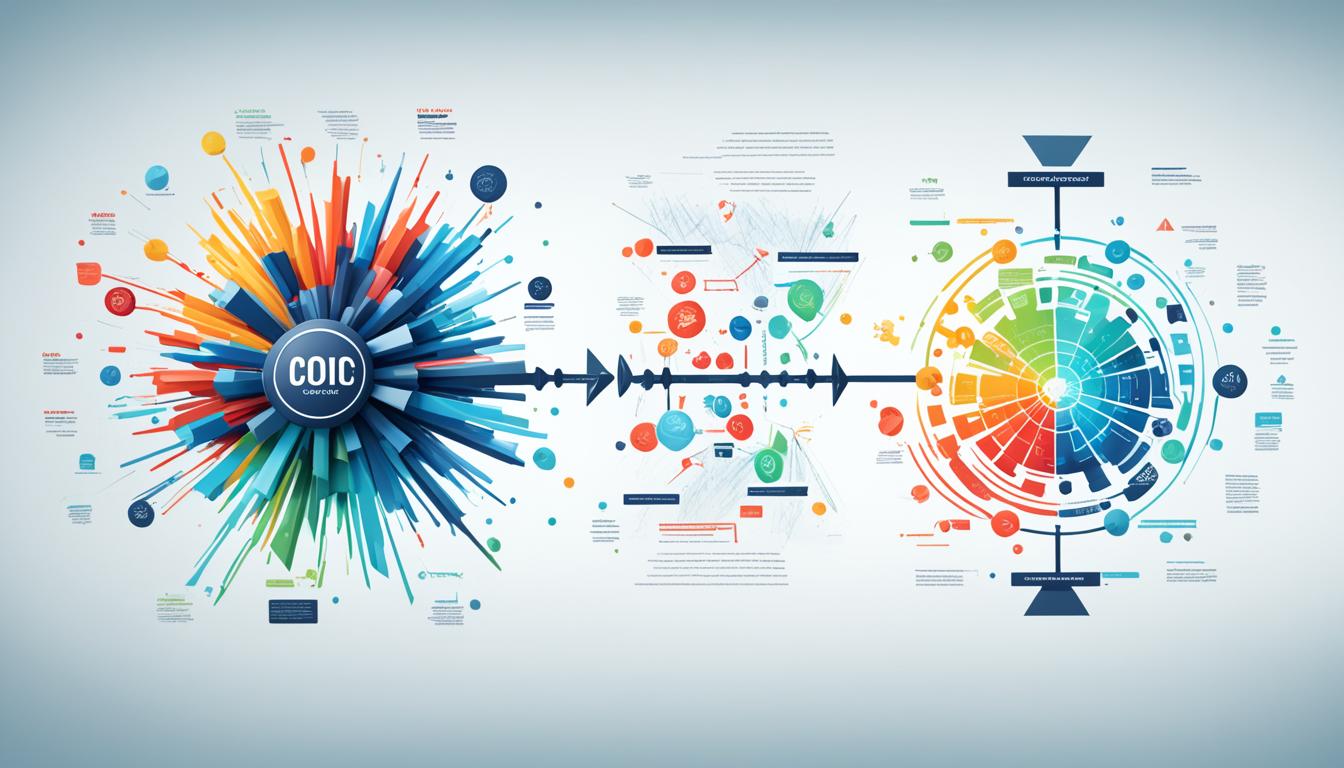In the world of digital marketing, two prominent strategies have emerged as essential components of a successful digital strategy: content marketing and performance marketing. While both approaches aim to drive results and boost business growth, they differ in their focus and methodology. Understanding the key differences between content marketing and performance marketing is crucial for refining your digital strategy and achieving maximum impact online.
Key Takeaways:
- Content marketing focuses on providing valuable and relevant content to attract and engage the target audience.
- Performance marketing, on the other hand, focuses on driving conversions and optimizing campaigns for specific goals and measurable outcomes.
- Inbound marketing, social media marketing, SEO optimization, paid advertising, and marketing analytics are essential elements of both content marketing and performance marketing strategies.
- Content marketing aims to build long-term relationships with customers and establish brand authority, while performance marketing focuses on immediate, tangible results.
- Combining both content marketing and performance marketing techniques can lead to a comprehensive and effective digital marketing strategy.
What is Digital Marketing?
Digital marketing, also known as online marketing, is a strategic approach to promote businesses, products, or services through various digital channels. It leverages the power of the internet to connect with potential customers and drive traffic to a business website.
Digital marketing encompasses a wide range of tactics and techniques to achieve different objectives, such as increasing brand awareness, generating leads, and converting prospects into paying customers. It utilizes various channels, including but not limited to:
- Social Media Marketing – leveraging popular social media platforms like Facebook, Instagram, and Twitter to engage the target audience, build a brand presence, and drive website traffic.
- Email Marketing – utilizing email campaigns and newsletters to reach out to potential customers, nurture leads, and encourage repeat business.
- Search Engine Marketing – optimizing websites for search engines (SEO) and running paid search advertising (PPC) to gain visibility in search engine result pages and drive organic and paid traffic.
- Display Advertising – placing visually appealing banner ads on relevant websites to increase brand exposure and attract potential customers.
- Video Marketing – creating and distributing engaging video content on platforms like YouTube to educate, entertain, and promote products or services.
- Mobile Marketing – reaching the target audience through mobile devices, such as SMS marketing, mobile apps, or mobile advertising.
- Pay-per-click Advertising – running online ads, where advertisers pay each time a user clicks on their ads, to drive targeted traffic to websites and landing pages.
Digital marketing is not limited to these channels alone and continues to evolve as new technologies and platforms emerge. It offers various payment models, such as cost-per-click (CPC), cost-per-action (CPA), and cost-per-thousand impressions (CPM), allowing businesses to tailor their strategies based on their objectives and budgets.
What is Performance Marketing?
Performance marketing is a specific form of digital media advertising that focuses on driving measurable results and outcomes. Unlike traditional advertising methods that rely on impressions, likes, and shares, performance marketing centers around client actions such as clicks, sales, and lead generation. Advertisers only pay for actual conversions, making it a cost-effective approach for businesses.
Performance marketing utilizes various paid media channels, including Google Adwords, Facebook ads, LinkedIn ads, and banner ads, to engage target audiences and drive conversions. By strategically optimizing campaigns, advertisers can generate leads and achieve their desired outcomes.
One of the key advantages of performance marketing is the ability to measure and track campaign metrics effectively. Advertisers can accurately monitor lead generation, conversion rates, and return on investment (ROI), which helps refine strategies and optimize performance.
Here is a table highlighting the main payment models used in performance marketing:
| Payment Models | Description |
|---|---|
| Cost Per Click (CPC) | Advertisers pay for each click their ad receives. |
| Cost Per Action (CPA) | Advertisers pay only when a specific action, such as a sale or lead, is completed. |
| Cost Per Mille (CPM) | Advertisers pay per 1000 impressions of their ad. |
These payment models offer flexibility and allow advertisers to align their budgets with the desired outcomes. By selecting the appropriate payment model for their goals, advertisers can effectively manage their marketing investments.
Performance marketing is an integral part of a comprehensive digital marketing strategy as it focuses on generating tangible results and driving conversions. By leveraging paid media channels and optimizing performance metrics, businesses can achieve their objectives efficiently and effectively.
Metrics to Measure Performance Marketing
Performance marketing relies on various metrics to evaluate the effectiveness of campaigns and track performance. These metrics provide valuable insights into the success of marketing efforts and help optimize strategies for better results. Here are some essential performance marketing metrics:
- Cost Per Mille (CPM): CPM measures the cost associated with showing an ad to 1000 viewers. It is calculated by dividing the total cost of impressions by the number of impressions and is useful for evaluating the efficiency of ad placement.
- Cost Per Click (CPC): CPC measures the cost of each click on an ad. It helps evaluate the effectiveness of ad campaigns in driving targeted traffic to a website or landing page. A lower CPC indicates more efficient ad spend.
- Cost Per Action (CPA): CPA measures campaign performance based on the actions taken by the target audience, such as filling out a form, subscribing to a newsletter, or making a purchase. It helps assess the return on investment (ROI) of specific actions.
- Lifetime Value (LTV): LTV calculates the expected spending of each customer over their lifetime. It considers factors such as repeat purchases, upsells, and referrals. LTV helps businesses understand the long-term value of acquiring and retaining customers.
By tracking these performance marketing metrics, businesses can gain valuable insights into the effectiveness of their campaigns, make data-driven decisions, and optimize their marketing strategies for better results.
Metrics to Measure Digital Marketing
Digital marketing relies on specific metrics to assess its effectiveness and measure campaign performance. By tracking these metrics, businesses can gain valuable insights into the success of their digital marketing strategies. Here are some of the key digital marketing metrics to monitor:
Bounce Rate
The bounce rate measures the percentage of visitors who leave a website without taking any action or exploring further. A high bounce rate may indicate that the website is not engaging or relevant to the target audience. It could also suggest usability issues or slow page load times.
Page Views
Page views refer to the total number of pages viewed by visitors on a website. This metric helps assess how engaging the content is and how effectively it encourages users to explore different sections of the website. An increase in page views suggests that visitors are finding the content valuable and are motivated to consume more.
Conversion Rate
The conversion rate measures the percentage of visitors who take a desired action on a website, such as making a purchase, filling out a form, or subscribing to a newsletter. It is a critical metric for evaluating the effectiveness of a digital marketing campaign in driving desired outcomes. A higher conversion rate indicates that the website is successfully convincing visitors to take action.
Click-Through Rate (CTR)
The click-through rate (CTR) is the ratio of total clicks on a digital ad or a specific link to the total number of viewers. This metric helps assess the effectiveness of ads in attracting the attention and interest of the target audience. A higher CTR indicates that the ad is compelling and persuasive, encouraging users to click and explore further.
Measuring these digital marketing metrics provides valuable insights into the performance of campaigns and helps identify areas for improvement. By tracking and analyzing these metrics regularly, businesses can optimize their digital marketing strategies for better results.
Types of Performance Marketing
Performance marketing encompasses various types that cater to different objectives and target audiences. These types include:
1. Search Performance Marketing
Focusing on paying for search ads to drive traffic to a website by targeting the right keywords.
2. Social Performance Marketing
Utilizing paid ads and organic posts on social media platforms, emphasizing high-quality content to engage and attract customers.
3. Email Performance Marketing
Leveraging email marketing strategies to grow a business, targeting the right audience and measuring email open rates.
4. Publisher Performance Marketing
Involving paid ads displayed on websites and apps that the advertiser does not own, driving traffic to a website.
5. Affiliate Performance Marketing
Aiming to generate commission-based sales by partnering with affiliate publishers and influencers.
Here is a table summarizing the key features of each type:
| Type | Description |
|---|---|
| Search Performance Marketing | Focusing on search ads and targeting keywords to drive website traffic. |
| Social Performance Marketing | Utilizing paid ads and organic posts on social media platforms to engage and attract customers. |
| Email Performance Marketing | Using email marketing strategies to target the right audience and measure open rates. |
| Publisher Performance Marketing | Displaying paid ads on third-party websites and apps to drive traffic to a website. |
| Affiliate Performance Marketing | Generating commission-based sales through partnerships with affiliate publishers and influencers. |
By understanding the different types of performance marketing, businesses can effectively tailor their strategies to achieve their goals and reach their target audience.
Types of Digital Marketing
Digital marketing encompasses various types and strategies that businesses can utilize to achieve their marketing goals. Some common types of digital marketing include:
- Content Marketing: Creating high-quality, useful content in various forms such as blogs, social media posts, videos, webinars, infographics, templates, datasheets, and reports, to provide value to the target audience.
- Search Engine Marketing: Focusing on getting websites to the top of search engine result pages through SEO optimization and paid advertising.
- Social Media Marketing: Utilizing social media platforms to engage with and promote to the target audience through organic postings and paid advertisements.
- Paid Advertising: Including paid ads with two different payment models, PPC (Pay Per Click) and CPM (Cost Per Mile), to increase visibility and reach.
| Types of Digital Marketing | Description |
|---|---|
| Content Marketing | Involves creating high-quality, useful content in various forms to provide value to the target audience. |
| Search Engine Marketing | Focuses on getting websites to the top of search engine result pages through SEO optimization and paid advertising. |
| Social Media Marketing | Utilizes social media platforms to engage with and promote to the target audience through organic postings and paid advertisements. |
| Paid Advertising | Includes paid ads with two different payment models, PPC (Pay Per Click) and CPM (Cost Per Mile), to increase visibility and reach. |
Which is Best for Your Business?
When deciding between content marketing and digital marketing strategies, it’s important to consider factors such as your budget and business goals. While online content marketing tends to outperform print content, utilizing a combination of both approaches can yield optimal results. Online content marketing, through the creation of educational and valuable material, can help increase your reputation, credibility, and global reach. By integrating both content marketing and digital marketing methods and optimizing audience engagement, you can develop a comprehensive marketing strategy that drives success.
- Target Audience Reach: Online content marketing allows you to reach a wider audience through various digital channels, capturing the attention of potential customers who are actively searching online for relevant information.
- Cost-Effectiveness: Digital marketing offers cost-effective options such as targeted ads and pay-per-click campaigns, enabling you to allocate your budget strategically and maximize your return on investment (ROI).
- Brand Awareness: By utilizing both content marketing and digital marketing, you can establish a strong brand presence online and offline, building brand awareness and recognition among your target audience.
- Flexibility: Digital marketing provides the flexibility to adjust your strategies and channels based on real-time results and market trends, allowing you to optimize your campaigns for better performance.
Ultimately, the best approach for your business may involve a customized combination of content marketing and digital marketing, tailored to your specific goals, target audience, and resources. By analyzing your budget, business objectives, and available content, you can develop a marketing strategy that leverages the strengths of both content marketing and digital marketing to achieve the greatest impact.
How to Create a Complementary Strategy With Content Marketing and Digital Marketing?
Creating a complementary strategy with content marketing and digital marketing involves several key elements that can enhance the effectiveness of your overall marketing efforts.
1. Define Your Marketing Goals
Start by clearly establishing your marketing goals, whether they are short-term objectives or long-term visions. Align these goals with the overall mission of your business to ensure a cohesive strategy.
2. Identify Your Target Audience
Understanding your target audience is crucial for both content marketing and digital marketing. Conduct thorough research to gain insights into their preferences, behaviors, and pain points. This knowledge will help you tailor your content and digital marketing tactics to effectively engage and convert your target audience.
3. Determine Your Marketing Tactics
Consider the various marketing tactics available to you and determine the most suitable ones based on your marketing goals and target audience. This may include a combination of content marketing tactics such as blogging, social media marketing, email marketing, and digital marketing tactics such as search engine optimization (SEO), pay-per-click (PPC) advertising, and social media advertising.
4. Set a Budget and Timeline
Allocate a budget that aligns with your marketing goals and consider the costs associated with both content marketing and digital marketing tactics. Establish a realistic timeline for implementing your strategy and achieving your desired outcomes.
5. Align with Your Business Mission
Ensure that your content marketing and digital marketing efforts are in line with the overall mission of your business. Maintain consistency in messaging, branding, and customer experience across all channels to create a cohesive and unified marketing approach.
By combining the power of content marketing and digital marketing techniques, you can create a complementary strategy that maximizes your marketing goals, effectively engages your target audience, and drives overall marketing success.
How Do Content Marketing and Digital Marketing Offer Different Advantages?
Content marketing and digital marketing each offer unique advantages that businesses can leverage to achieve their goals. By understanding how these strategies differ, companies can optimize their marketing efforts and maximize their impact.
Advantages of Content Marketing
Content marketing provides several key advantages for businesses:
- Establishing Relationships with Clients: Through valuable and informative content, businesses can build trust and establish strong relationships with their target audience. By consistently delivering content that addresses their needs and interests, businesses can foster loyalty and long-term engagement.
- Improving Search Engine Exposure and Organic Rankings: Content marketing plays a vital role in improving a website’s search engine visibility. By creating high-quality, keyword-rich content, businesses can enhance their organic rankings and attract more organic traffic to their website.
- Positioning the Brand as an Authority Figure: By consistently delivering valuable content, businesses can position themselves as industry experts and thought leaders. This establishes credibility, enhances brand reputation, and encourages customers to seek out the brand for their needs.
Advantages of Digital Marketing
Digital marketing offers several distinct advantages that can help businesses achieve their marketing objectives:
- Flexibility: Digital marketing allows businesses to quickly adjust their strategies and channels based on real-time data and results. This flexibility enables businesses to maximize their marketing efforts and optimize their campaigns for better performance.
- The Ability to Filter and Target the Ideal Audience: With digital marketing, businesses can precisely target their ideal audience based on demographics, interests, and online behaviors. This targeting capability ensures that businesses reach the right audience with their marketing messages, resulting in higher conversion rates and a more efficient use of resources.
- In-depth Data and Analytics: Digital marketing provides access to detailed data and analytics, allowing businesses to track the performance of their campaigns and gain valuable insights into their target audience’s behavior. This data-driven approach enables businesses to make informed decisions and continuously optimize their marketing strategies for better results.
By combining the advantages of content marketing and digital marketing, businesses can create a comprehensive marketing strategy that leverages the strengths of both approaches. This integration allows companies to build strong relationships with clients, improve search engine exposure, target the ideal audience, and adapt their strategies based on real-time data.

| Advantages of Content Marketing | Advantages of Digital Marketing | |
|---|---|---|
| Establishing Relationships with Clients | ✓ | |
| Improving Search Engine Exposure and Organic Rankings | ✓ | |
| Positioning the Brand as an Authority Figure | ✓ | |
| Flexibility | ✓ | |
| The Ability to Filter and Target the Ideal Audience | ✓ | |
| In-depth Data and Analytics | ✓ |
Conclusion
In conclusion, understanding the differences between content marketing and performance marketing is crucial for developing an effective digital strategy. Content marketing focuses on providing value and building relationships with potential customers, while performance marketing is centered around generating leads and driving conversions. Both approaches play vital roles in a comprehensive digital marketing strategy.
By leveraging the right mix of content marketing and performance marketing techniques, businesses can refine their digital strategy for maximum impact online. Content marketing allows brands to establish credibility, improve search engine exposure, and position themselves as authorities in their respective industries. On the other hand, performance marketing offers flexibility, the ability to adjust strategies based on results, and the opportunity to target and filter the ideal audience.
Integrating both content marketing and performance marketing tactics can help businesses achieve their marketing goals and optimize their digital presence. By providing valuable content and utilizing performance-focused campaigns, businesses can reach a wider audience, drive engagement, and ultimately increase conversions. This harmonious combination allows for a comprehensive approach that maximizes the benefits of both content marketing and performance marketing, resulting in a more impactful digital strategy.
FAQ
What is the difference between content marketing and performance marketing?
Content marketing focuses on providing value and building relationships with potential customers, while performance marketing focuses on generating leads and driving conversions.
What is digital marketing?
Digital marketing is online marketing that connects potential customers using the internet through various tools such as social media, email marketing, search engine marketing, display advertising, video marketing, mobile marketing, and pay-per-click advertising.
What is performance marketing?
Performance marketing is a form of digital media advertising that focuses on specific actions such as clicks, sales, and leads. It is result-centric and performance-based, where advertisers only pay for actual conversions.
What are some metrics used to measure performance marketing?
Some common performance marketing metrics include Cost Per Mille (CPM), Cost Per Click (CPC), Cost Per Action (CPA), and Lifetime Value (LTV).
What are some metrics used to measure digital marketing?
Some common digital marketing metrics include Bounce Rate, Page Views, Conversion Rate, and Click-Through Rate (CTR).
What are the different types of performance marketing?
The different types of performance marketing include search performance marketing, social performance marketing, email performance marketing, publisher performance marketing, and affiliate performance marketing.
What are the different types of digital marketing?
The different types of digital marketing include content marketing, search engine marketing, social media marketing, and paid advertising (PPC and CPM).
How do I decide between content marketing and digital marketing for my business?
The decision between content marketing and digital marketing depends on factors such as budget and business goals. It is often beneficial to utilize a combination of both strategies for optimal results.
How can I create a complementary strategy with content marketing and digital marketing?
To create a complementary strategy, it is important to define marketing goals, target audience, marketing tactics, budget, timeline, and align efforts with the overall business mission.
What advantages does content marketing offer?
Content marketing offers advantages such as establishing relationships with clients, improving search engine exposure and organic rankings, and positioning the brand as an authority figure.
What advantages does digital marketing offer?
Digital marketing offers advantages such as flexibility, the ability to adjust strategies based on results, and the opportunity to filter and target the ideal audience.





